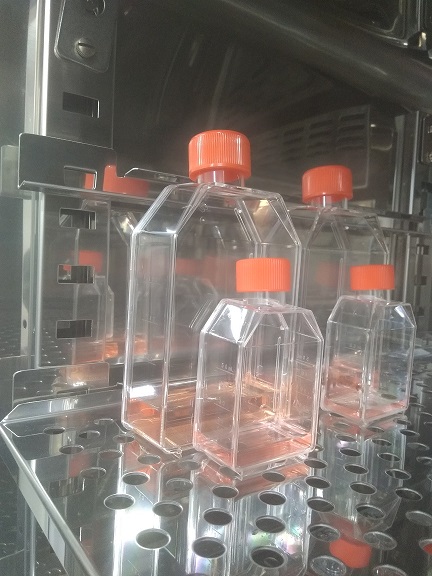The living cells that are cultured may include:
- Cells – (e.g. blood and microbial cells)
- Tissues – (e.g. skin)
- Organs – (e.g. heart)
When a whole organ or intact organ fragments of an organism (plant or animal) are removed from an organism and cultured in vitro for the purpose of studying their function and development, the process is called organ culture. The culturing of cells, tissues or organs occurs in vitro i.e. in glass or cell culture dishes or flasks; and this is opposed to in vivo processes (i.e. natural processes that occur inside the whole organism from which the cells or tissues where obtained from).
The artificial environment that cell culture provides, and in which cells are engineered to grow in, usually consists of a suitable plastic or glass culture vessel containing liquid or semi-solid medium that supplies all essential growth nutrients for the survival of the cells, tissues or organs being cultured in vitro.
Several sizes of these flasks (usually in the range of 10 – 180 cm2) exist for cell (tissue) culture techniques. While the cap of some of these flasks is vented i.e. some flasks have openings on their caps (Figure 1: Flask B) others are not vented and have no openings on their caps (Figure 1: Flask A). Some tissue (cell) culture flaks are multilayered (e.g. some have up to 5 layers) while others are single layered (Figure 1).
Vented cell/tissue culture flasks provide or allow excess CO2 generated within the culture flask to exit the flask or to allow CO2 to enter the flask when incubated inside a CO2 humidified incubator. Other types of vessels used for cell (tissue) culture apart from the vented and non-vented flasks shown here include the stirrer flasks, multiwall plates, screw-capped vials/phials, Petri dishes and screw-capped conical flasks.

References
Alberts B, Bray D, Johnson A, Lewis J, Raff M, Roberts K andWalter P (1998). Essential Cell Biology: An Introduction to the Molecular Biology of the Cell. Third edition. Garland Publishing Inc., New York.
Alberts B, Bray D, Lewis J, Raff M, Roberts K and Watson J.D (2002). The molecular Biology of the Cell. Fourth edition. New York, Garland, USA.
Ausubel, F.M., Brent, R., Kingston, R.E., Moore, D.D., Seidman, J.G., Smith, J.A., Struhl, K., eds (2002). Short Protocols in Molecular Biology, 5th edn. John Wiley & Sons, New York.
Caputo J.L (1996). Safety Procedures. In: Freshney, R.I., Freshney, M.G., eds., Culture of Immortalized Cells. New York, Wiley-Liss, Pp. 25-51.
Cooper G.M and Hausman R.E (2004). The cell: A Molecular Approach. Third edition. ASM Press.
Davis J.M (2002). Basic Cell Culture, A Practical Approach. Oxford University Press, Oxford, UK.
Freshney R.I (2005). Culture of Animal Cells, a Manual of Basic Technique, 5th Ed. Hoboken NJ, John Wiley and Sons Publishers.
Health Services Advisory Committee (HSAC) (2003). Safe Working and the Prevention of Infection in Clinical Laboratories. HSE Books: Sudbury
Lodish H, Berk A, Matsudaira P, Kaiser C.A, Kreiger M, Scott M.P, Zipursky S.L and Darnell J (2004). Molecular Cell Biology. Fifth edition. Scientific American Books, Freeman, New York, USA.
Marcovic O and Marcovic N (1998). Cell cross-contamination in cell cultures: the silent and neglected danger. In Vitro Cell Dev Biol. 34:108.
Mather J and Barnes D (1998). Animal cell culture methods, Methods in cell biology. 2rd eds, Academic press, San Diego.
Verma P.S and Agarwal V.K (2011). Cytology: Cell Biology and Molecular Biology. Fourth edition. S. Chand and Company Ltd, Ram Nagar, New Delhi, India.
Discover more from Microbiology Class
Subscribe to get the latest posts sent to your email.




